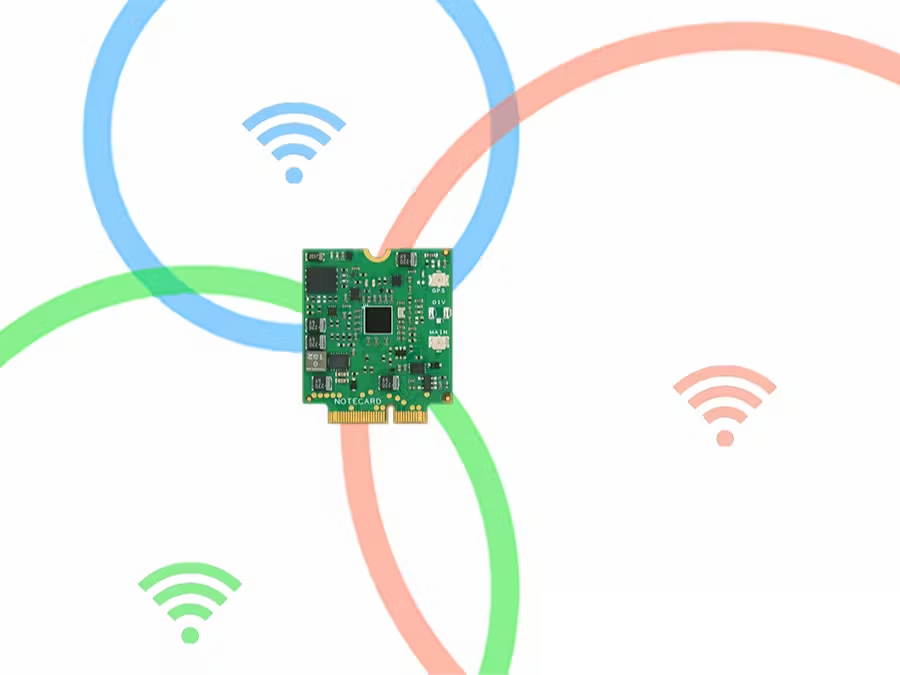
In our digitally connected world, finding your way outdoors has become a relatively simple task thanks to GPS and mapping apps. However, navigating indoor spaces can often prove to be a challenge. Whether it’s a sprawling shopping mall, a labyrinthine airport, or a large office complex, finding a specific store, gate, or office within these indoor spaces can be a daunting task. Fortunately, indoor location services powered by Wi-Fi triangulation are changing the game, offering precise navigation and personalized experiences within enclosed environments.
Learn more about the Zebra EC30 here!
Optimize your indoor location services – Contact Bluefletch for tailored solutions!
Indoor Location Services
Wide adoption of smartphones has enabled people to use location services and learn more about the world around them. As usage of location services has increased, so has the desire to improve the accuracy and precision of their determined position on a map.
GPS is traditionally used outdoors and enables accuracy within 3 meters; however, GPS cannot be used reliably, if at all, inside of buildings. Signals become degraded and location cannot be accurately determined. This limits the reach of location services to only outdoor application.
Below we will look at a few emerging technologies and how they are used to overcome the challenges surrounding indoor location services.
Introduction
Since GPS and cell tower triangulation were introduced to smartphones in the mid 2000s, three-quarters of all smartphone users regularly take advantage of their current location to get information or directions relevant to the world around them.
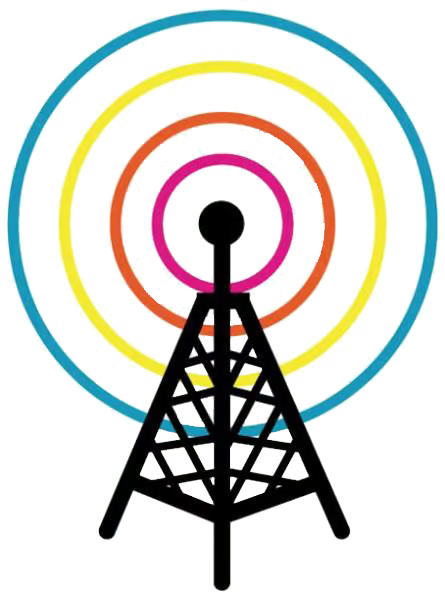
This functionality enables interacting with your environment possible on a large scale. However, when people want to interact through their mobile devices with surroundings on a much smaller scale, i.e. further information about a painting in a front of them at a museum, GPS and cell tower triangulation cannot provide precise enough location.
Utilizing WiFi signals, iBeacons and sensors built into mobile devices, new offerings have hit the market capable of providing highly accurate indoor positioning. The ability to bring the coveted experience of context-aware applications indoors creates many opportunities in retail, tourism, and healthcare, among others.
Context-aware applications provide services that are relevant and appropriate to a particular person, place and time. With minimal effort, interaction with surroundings becomes seamless. This nearly invisible computation has become a given with many applications we use everyday.
To bring this same context-awareness to a hyper-local level, technologies beyond GPS and cell-tower triangulation need to be considered. Hardware already common on most smartphones has been, in a sense, repurposed to provide higher accuracy for positioning. Below are some of the common hardware components and sensors accessed to augment traditional location services.
The Challenge of Indoor Navigation
Indoor navigation presents unique challenges that differ significantly from outdoor navigation. GPS signals, which are the backbone of outdoor navigation, often struggle to penetrate buildings effectively. As a result, traditional GPS-based systems are unreliable within indoor environments, leading to confusion, frustration, and wasted time for visitors. Learn more about Apple in the marketplace here!
This gap in navigational support has sparked the development of indoor location services that leverage Wi-Fi networks. These systems utilize the existing infrastructure of Wi-Fi access points to provide location-based services within buildings.
How Wi-Fi Triangulation Works
Wi-Fi triangulation, also known as Wi-Fi fingerprinting or positioning, relies on the strength and unique identifiers of nearby Wi-Fi access points to determine a device’s location indoors. Here’s a simplified explanation of how it works:
Scanning for Wi-Fi Signals: When a user’s device (such as a smartphone) with Wi-Fi enabled enters an area, it scans for nearby Wi-Fi access points and records their signal strengths and MAC addresses.
Creating Wi-Fi Fingerprints: These signal strength and MAC address combinations are then compared and mapped against a database of known fingerprints for different areas within the building. This creates a unique fingerprint for each location.
Triangulating the Position: By analyzing the received signals from multiple access points and comparing them to the known fingerprints, the system can determine the device’s approximate location within the building.
Benefits of Indoor Location Services
Precision and Accuracy: Wi-Fi triangulation offers precise indoor location accuracy, often down to a few meters, enabling users to navigate complex indoor spaces confidently.
Enhanced User Experience: Indoor location services power personalized experiences by providing location-based information, such as nearby amenities, promotions, or points of interest.
Wayfinding and Navigation: Visitors can easily navigate large buildings, find specific stores, offices, or facilities without getting lost or disoriented.
Business Opportunities: For businesses operating within these spaces, indoor location services offer opportunities for targeted marketing, customer engagement, and analytics to understand visitor behavior and preferences.
Real-World Applications
The applications of indoor location services powered by Wi-Fi triangulation are diverse and impactful:
Retail Environments: Retailers use indoor navigation to guide customers to products, offer personalized promotions, and streamline the shopping experience.
Healthcare Facilities: Hospitals utilize indoor location services to guide patients, visitors, and staff efficiently within their complex layouts.
Transportation Hubs: Airports and train stations employ indoor navigation to assist travelers in finding boarding gates, amenities, and services.
Smart Offices: Corporates adopt indoor location services to optimize office layouts, enable room booking systems, and enhance workplace producti
Enhance customer experiences with precise indoor navigation – Schedule a call!
Sensors and Hardware Used for Indoor Location
Hardware
-WiFi Antenna
-Bluetooth
-GPS
Sensors
-Magnetomer
-Accelerometer
-Altimeter*
-Pedometer*
*Visual sensor: information is derived from other hardware sensors
WiFi Location Services
The most common enabler of indoor location positioning is WiFi signals. Using the measured intensity of received signal strength from a wireless access point, distance can be calculated based on a calibrated value. A minimum of three access points must be in range to determine a single location.
With just one access point, the devices location could theoretically be on any point on a circumference where radius is equal to a calculated distance based on signal strength. With two access points, a devices location could be one of two spots: the intersections of the circumferences of two access points. When three access points are in range, there is only one possible location; the intersection of three circumferences as illustrated in the diagram below.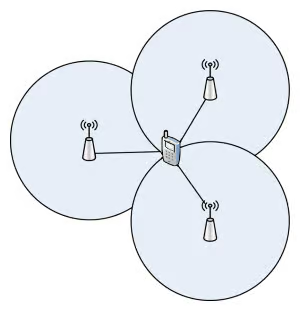
This process of calculating position using geometrical measurements of circles and triangles is known as trilateration.
WiFi based location also uses fingerprinting to aid with location accuracy. Fingerprinting is the process of collecting location and associating it with nearby access points SSID and MAC addresses. This location information is stored anonymously in a database by companies like Apple and Google and then used to improve location retrieval and accuracy for others in the future. This is why phones prompt you to turn on WiFi to improve location accuracy.
With multiple fingerprinted access points inside of a building, trilateration can be used to determine a position within 2.5 meters of accuracy. This is comparable to the accuracy of GPS systems when used outdoors.
iBeacons
iBeacons can either be used to complement or in place of WiFi access points for trilateration. Similar to WiFi positioning, iBeacons estimate distance based on received signal strength from Bluetooth Low Energy signals emitted by iBeacons. iBeacons are golf ball-sized, battery powered devices which constantly broadcast their presence. If three or more iBeacons are in range and have a known location, position can be determined.
Setting up a wide array of iBeacons at your location has some benefits in comparison to a WiFi location framework. iBeacons are cheap ($50), secure, simple and easy to tune ( i.e. signal strength). However, iBeacons are better used for proximity and notifications rather than location. If using iBeacons solely for location, they should have their broadcasting power set to maximum so that as many iBeacons are visible as possible. This drain on battery is one of the reasons iBeacons are better used in combination with WiFi networks. Also, users must have downloaded an application and enabled Bluetooth before they can begin locating and receiving notifications.
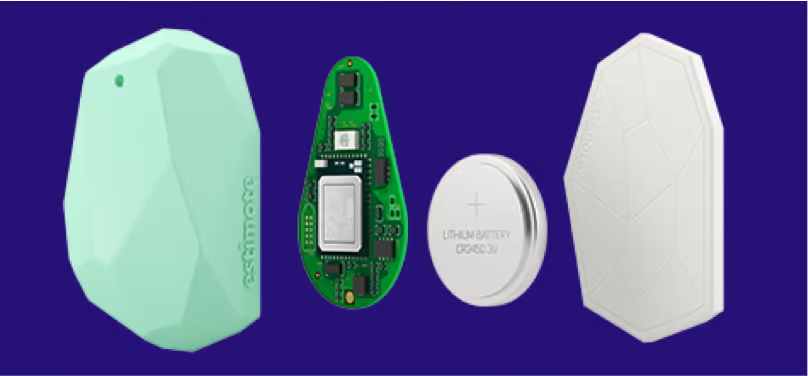
Communication with iBeacon devices is only compatible on iPhone 4S / iPad 3 and upwards running iOS 7+ (over 75% of iPhones in use) as well as Android devices running version 4.3 and upwards (almost 25% of devices in use). Fluctuations in signals are generally greater on Android devices. This can be attributed to Apple’s Core Location framework using noise reduction methods for Bluetooth LE signals.
Magnetometer
The magnetometer is a sensor included in most mobile devices that is commonly used as a digital compass on the device. One company in particular has reimagined the magnetometers purpose. Instead of using the sensor to find North, it is used to detect magnetic disturbances indoors.
Buildings constructed with steel beams, wall studs, and other materials emit a magnetic field which is detected by the magnetometer. These fields are mapped and associated with points on a map to enable indoor location services without any additional setup. A user doesn’t need to enable WiFi or Bluetooth to use this type of system.
New with iOS 8
With the announcement of iOS 8, Apple introduced their own indoor location service built into the operating system. Utilizing the M7 motion chip and WiFi / iBeacon technology, iPhone 5s and greater can recognize when a user is indoors and begin detecting location. The operating system also shuts down Cell and GPS tracking when indoors for battery savings. This technology will initially be used in public places where Apple is able to map in collaboration with building owners.
Final Thoughts
As the demand for seamless indoor navigation grows, so does the importance of indoor location services powered by Wi-Fi triangulation. These technologies offer a solution to the challenges of navigating complex indoor spaces, providing users with precise location information and businesses with opportunities for improved customer engagement and operational efficiency.
With continuous advancements in technology and the integration of indoor mapping solutions into everyday applications, the future of navigating indoor spaces looks promising, making getting from point A to point B within large buildings as effortless as navigating the streets outside. Unlock the potential of indoor location technology – Let Bluefletch be your guide!
